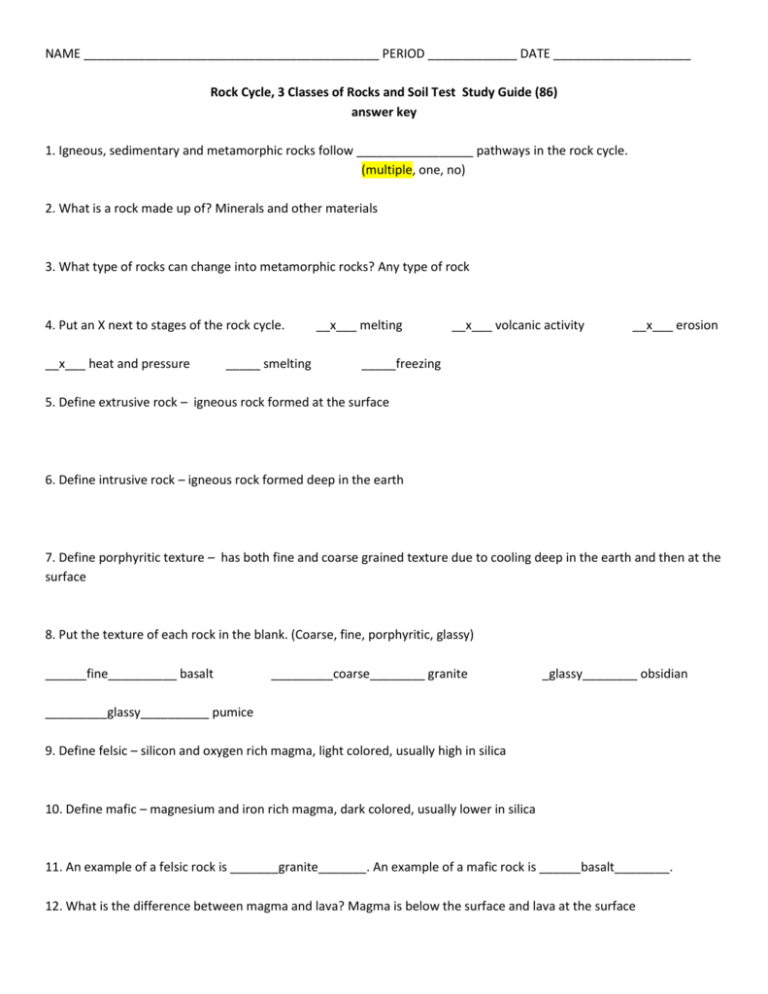Rock Cycle Study Guide Answer Key
advertisement

NAME ___________________________________________ PERIOD _____________ DATE ____________________ Rock Cycle, 3 Classes of Rocks and Soil Test Study Guide (86) answer key 1. Igneous, sedimentary and metamorphic rocks follow _________________ pathways in the rock cycle. (multiple, one, no) 2. What is a rock made up of? Minerals and other materials 3. What type of rocks can change into metamorphic rocks? Any type of rock 4. Put an X next to stages of the rock cycle. __x___ heat and pressure _____ smelting __x___ melting __x___ volcanic activity __x___ erosion _____freezing 5. Define extrusive rock – igneous rock formed at the surface 6. Define intrusive rock – igneous rock formed deep in the earth 7. Define porphyritic texture – has both fine and coarse grained texture due to cooling deep in the earth and then at the surface 8. Put the texture of each rock in the blank. (Coarse, fine, porphyritic, glassy) ______fine__________ basalt _________coarse________ granite _glassy________ obsidian _________glassy__________ pumice 9. Define felsic – silicon and oxygen rich magma, light colored, usually high in silica 10. Define mafic – magnesium and iron rich magma, dark colored, usually lower in silica 11. An example of a felsic rock is _______granite_______. An example of a mafic rock is ______basalt________. 12. What is the difference between magma and lava? Magma is below the surface and lava at the surface 13. An example of a coarse grained rock is ______granite_____. It is _______light__________ colored so it has (light or dark) _________lots of_______________ silica and is a ________felsic__________ rock. (lots of or not much) (felsic or mafic) 14. An example of a fine grained rock is ______basalt_______. It is _______dark__________ colored so it has (light or dark) _________not much_______________ silica and is a ______mafic____________ rock. (lots of or not much) (felsic or mafic) 15. Choose the correct igneous rock for each description below. Rock choices: Basalt Granite Obsidian Pumice _______basalt__________________ a dark, dense rock with a fine-grained texture, found in ocean crust, a common extrusive rock _________pumice________________ a light, less dense rock that floats on water, has no grains/crystals ________granite_________________ a usually light colored rock, coarse-grained, found in continental crust, a common intrusive rock __________obsidian_______________ a shiny dark colored rock, has no grains/crystals, sometimes called volcanic glass 16. Rocks that cool very, very, very quickly will have __________no_______________ grains/crystals. (large, small, no) 17. Rocks that cool quickly will have ________small_________________ grains/crystals. (large, small, no) 16. Rocks that cool slowly will have ________large_________________ grains/crystals. (large, small, no) 17. The most abundant intrusive igneous rock is ___________granite_______________. 18. The most abundant extrusive igneous rock is __________basalt________________. 19.. Arrange the steps to the formation of sedimentary rock in order from first(#1) to last (#5). Then define each. ___5__ cementation – The formation of crystals that glue the rock together ___2__erosion – The movement of Sediment ___1__ weathering – The breaking up of a rock into sediment ___4__ compaction – The pressing together of sediment under its own weight ___3__ deposition – Where sediment comes to rest, or is deposited 20. Define chemical weathering – occurs when there are changes in the chemical compositions of the rock or minerals from exposure to the environment. Chemical weathering includes chemical changes that may decompose, dissolve or break down various parts of the rock or other landform. These changes are a result of other minerals and chemicals that seep into rocks, usually in rain water or as gases. Acid rain is a prime cause of chemical weathering. 21. Define mechanical (physical) weathering – when rocks and other landforms are broken down by physical factors in the environment. These physical factors include wind, water, sun, ice and temperature changes. This type of weathering does not change the chemical composition of the rock or minerals. An example would be waves crashing against a rocky shoreline, slowly breaking apart the rocks into smaller pieces. 22 . Name the three types of sedimentary rocks and define them. 1.clastic – made of fragments of rock 2. organic – made of living sediments or were once living 3. chemical – made from sediments and minerals that precipitate out of solution 23. Name the two types of metamorphic rocks and define them. 1. foliated – layered or banded texture 2. non-foliated – texture is random 24. Which of the following is NOT a clastic rock (circle it). Sandstone breccias granite shale 25. What kind of sedimentary rock is chalk? ______________organic_______________________ 26. Where does the heat that changes a rock into a metamorphic one come from? ____________mantle________ 27. Geologists classify metamorphic rocks according to their ___________________texture______________________________. 28. Heat and pressure beneath the Earth’s surface can change any rock into a metamorphic____ rock. 29. Define foliated – layered or banded texture 30. Define nonfoliated – texture of grains is random 31. Draw a picture of 4 layers of rock and label the oldest and youngest. Youngest layer is at the top and oldest at the bottom. 32. Which layer represents an igneous rock? _____1_____________ Which layer represents a sedimentary rock? ______2____________ Which layer represents a metamorphic rock? _________3______________ Which layer represents cloud? __________4________________ 34. What is the formula for density? _______D=M/V______________________ 38. What energy transfer would occur when transferring heat through a rock? _________conduction_____________________ 39. Define abrasion – The process of wearing away a surface by friction. A rock undergoes abrasion when particles of sand or small pieces of rock are carried across its surface by a glacier, stream, or the wind. 40. Describe “ice wedging.” An ice wedge is a crack in the ground formed by a narrow or thin piece of ice that measures up to 3–4 meters in length at ground level and extends downwards into the ground up to several meters. During the winter months, the water in the ground freezes and expands.






